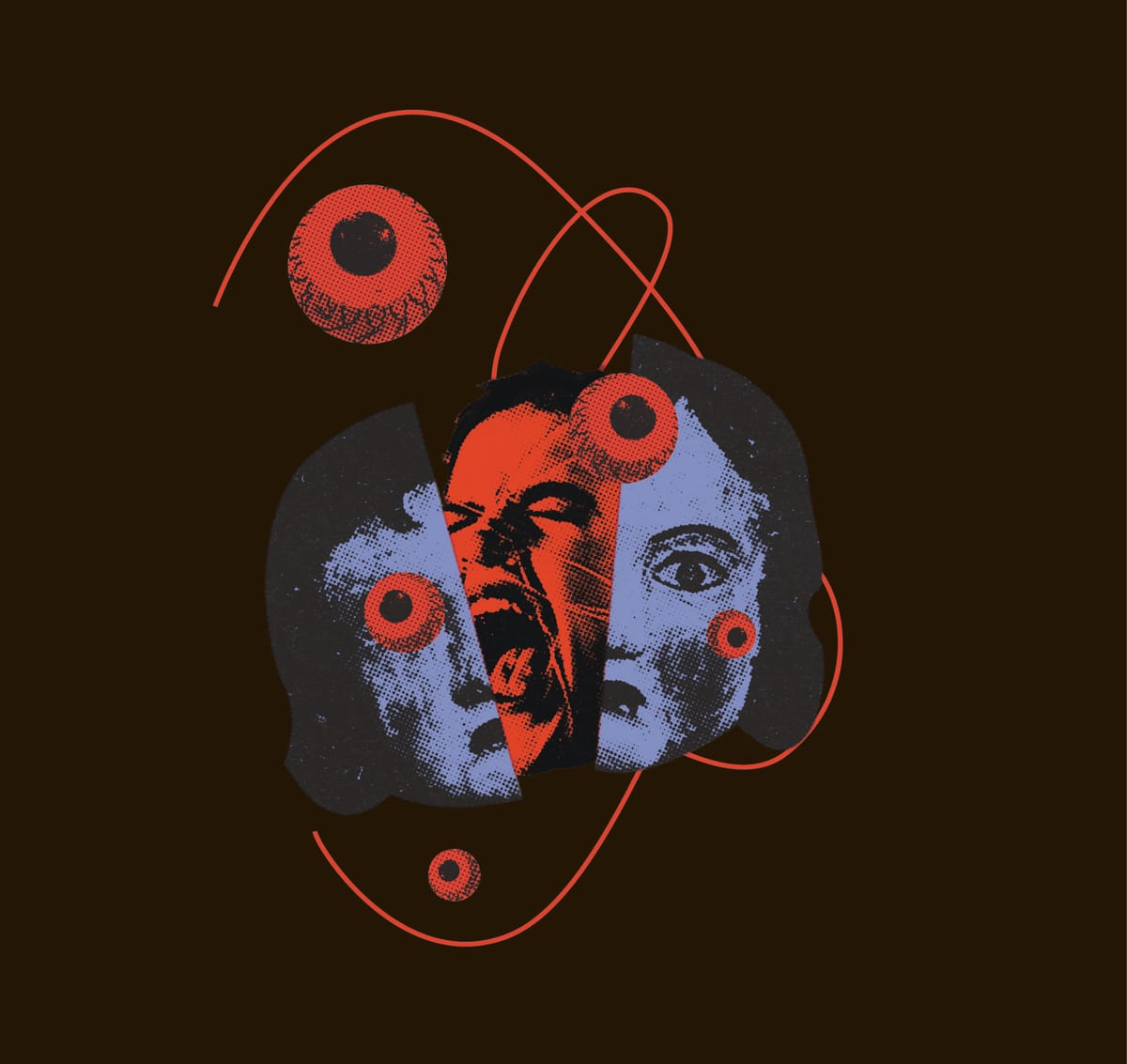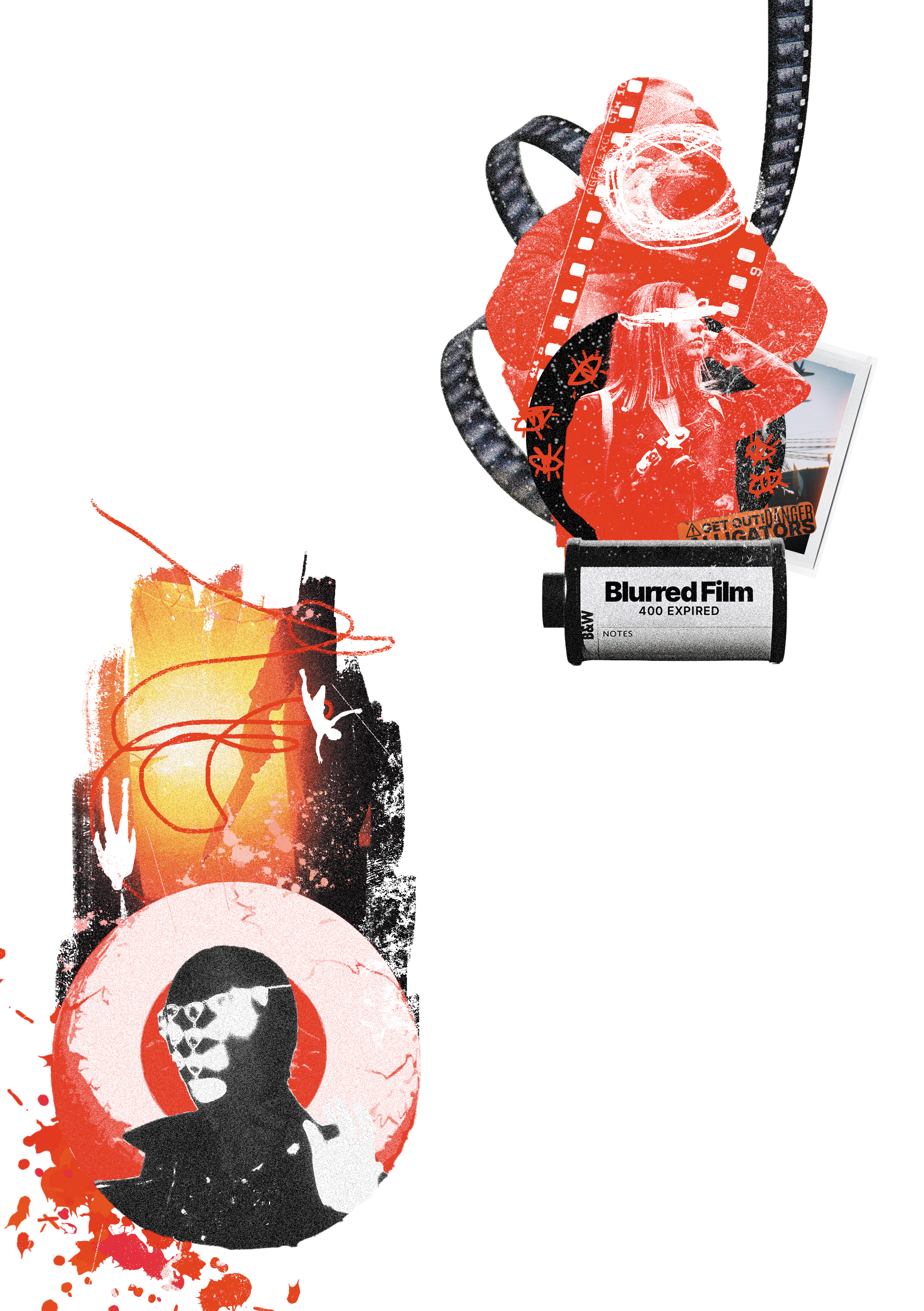
Providing us with a completely different take on the horror roleplaying experience is Blurred Lines - the latest title from Brazilian artist and game designer Guilherme Gontijo. Inspired by the Italian giallo movies that first came to prominence in the 1960s, Blurred Lines takes us away from the terror of the supernatural and into a world where the horrors are all too human.
A solo journalling RPG, Blurred Lines sees you slip off your socks and slide on your finest Italian leather loafers as you take on the role of a crime photographer, who is hunting, and in turn being hunted by, a serial killer who, at the start of the game, has just claimed their fourth victim.
Befitting the genre the killer’s MO is particularly grisly, garroting their victims with a fishing line, before extracting their left eye for good measure and it’s a race against time to uncover their identity before you too end up, laid out in similar cyclopean fashion, on the mortuary slab. But what, I wondered, was it about dark Italian cinema of the 1960s that so inspired this 33 year old graphic designer from Brasília?
‘Italian Cinema was pretty present all my life.’ he explains, his father a fan of Sergio Leone’s Spaghetti Westerns. As for giallo itself, a lurid sub-genre of Italian cinema that focuses on the brutal misdeeds of serial killers and the tortured psyches of those hunting them, Gontijo’s route in was, as for many, the legendary director Dario Argento’s Suspiria.
‘I was already a fan of the creative use of colors to set the psychological moods of the characters, mostly because of Kubrick, so when I saw Suspiria it felt more like an art movie than an horror one. It was love at first sight. The initial shot on the airport, the noisy creepy soundtrack, the geometric visuals. It was all there. Since that day I've watched as many giallo movies as possible.’
Another more direct inspiration for Blurred Lines also comes from Gontijo’s love for Italian cinema, in the shape of Michelangelo Antonioni’s 1966 classic, Blow-Up. As he explains the story of a fashion photographer who, ‘accidentally captures a clue to the identity of a serial killer on the background of one of his photos and becomes obsessed by it.’
Blurred Lines then opts for the slow-burn approach, the drama ratcheting up each turn as the clock, or in the game’s case it’s Killer Track, ticks down.
‘This process of progression and unveiling is The Horror,’ he explains. ‘A monster, a slasher killer or a not-so-loving neighborhood are just the climax of this discovery path. When we see the dangers we're dealing with, we can comprehend them and therefore contain them. Staying in the dark (even in daylight) is a major part of what makes the horror genre scary.’
Whilst the game does include optional rules for adding supernatural elements, the game’s main focus is on more mundane horrors which makes it stand out in a gaming sea of terrifying tentacles and maleficent magic. As Gontijo tells me, ‘I think most horror games confound horror with the aesthetic of horror. Basically it's the difference between "scary" and "jump scare". Horror, in my humble opinion, is most effectively sustained when we don't know what we're dealing with.’
So far, so tense, and a solo RPG is just the format to really immerse yourself in this high stakes game of gatto-e-topo. Utilising a deck of cards, a D10 and a wonderfully tactile mechanic that sees you scribble clues on post-it notes that you apply to a city map, Blurred Lines will soon have you speeding through the streets on your moped, photographing crime scenes and dealing with everything that the game’s prompts throw at you from celebrity car crashes to disturbing animal masked assailants.
‘Every time you visit a place you have to roll against a challenge,’ Gontijo explains. ‘If you win, the book will ask you certain questions and move you closer to the killer's identity. If you lose, however, the book will tell you what happened and move the killer closer to your character. When you take a picture you glue a post-it on the map with three rows representing the Foreground, Midground and Background of the picture. Then during the game you need to revisit the locations to re-examine the photos, and clarify your memory.’
Playing roleplaying games by oneself, especially late at night when you’re alone in the house, can be a powerful experience, especially with horror games, a responsibility on the part of the games designer that Gontijo clearly understands.
‘Games, and especially solitaire ones, can allow players to explore the dark,’ Gontijo says. ‘Because of that authors can help players enjoy the goosebumps without breaking down in tears and trauma. Most of the bad experiences that people have had with horror could have been avoided just by letting them know beforehand what they were getting into. You can't recommend The Cell to people only by saying is about Jenifer Lopez going inside a serial killer's mind or worse: only saying its for mature audiences. They need to know before entering the experience there are several triggering graphical scenes regarding sexual violence, kidnapping, claustrophobia, torture, prejudice and violence against children. This is utterly important and when authors don't do it they are being irresponsible.’
For those who do want to immerse themselves even deeper into the Blurred Lines experience though, Gontijo has provided several options. There’s a beautifully designed deck of cards to go with the game, a brief videography of giallo films that he recommends checking out and he has curated a playlist of music featuring the likes of Ennio Morricone, Riz Ortolani and Bruno Nicolai to get you in a suitably stylish, if tense, mood. We might take a pass on his suggestion to wear a leather glove on one hand though, there is after all a fine line.

If Blurred Lines plot and mechanics take their inspiration from giallo films, then so to does the game’s look, this is a very stylish looking zine. A graphic designer by trade, Gontijo has drawn on the aesthetic cues of Italian cinema and the book is filled with spot illustrations, collages and fake movie posters, I’m not sure what the Italian for gesamtkunstwerk is but it surely applies here.
‘As with all design projects, everything started to take shape at the research phase,’ he explains. ‘I collated a lot of famous shots from films, giallo posters, Italian book covers, modernist logos, portraits of Italian actress and more such as the Thomas de La Rue deck of cards on a Pinterest board. I started noticing collage and raw image manipulation were a big thing back then. And that seemed like a good place to start.’
This wasn’t all just a case of style over substance though and the goal was more than just to look good. ‘The book takes you in and out the game’s universe every other spread,’ he tells me. ‘Sometimes you're looking into fake posters of fake movies to inspire your investigations, sometimes you're reading about dice roll and poker card mechanics.’
Gontijo’s talents as a graphic designer has seen his work on several other Wyrd Science favourites in recent months, such as Nate Treme’s Haunted Almanac and Leo Hunt’s Vaults of Vaarn, both released by Portuguese publisher Games Omnivorous, but for the moment he’s still focused on getting more of his own games out into the wild.
‘Working with Games Omnivorous is amazing, but I'm also, slowly, working on two solo skirmish wargames. I've been reading and playing a lot of solo war/board games to gather some mechanical references for those two new experiences.’
Much like Blurred Lines it appears that these two works-in-progress both take a path less trod and he describes one asa ‘pocket skirmish wargame’, whilst whilst the other, intriguingly is ‘a golf game.’ Apart from Tolkien’s brief suggestion that it was the hobbit Bandobras "Bullroarer" Took’s decapitation of the goblin Golfimbul that inspired the game we’ve yet to see much crossover between the world of fantasy and the so-called ‘sport of kings’, so we’ll look forward to that...
Still, for Gontijo, and his fellow South American designers, there remains an uncertain path between having an idea for a game and actually getting it to market. In our previous issue Brazilian games designer Diogo Noguiera introduced us to the vibrant RPGLATAM scene that Gontijo himself is a key part of. In the 12 months since we’ve seen several higher profile releases from the community, Noguiera himself scooping an ENNIE for his Old School Essential’s adventure, Halls of the Blood King, and British publisher Soulmuppet running a successful Kickstarter to publish five zines by Latin American writers.
It’s noticeable though that both of these required European publishers and Gontijo still sees a long way to go. ‘It probably will be an unpopular opinion,’ he explains ‘but I don't think things are progressing enough actually. Most of RPGLATAM Kickstarter campaigns we saw only happened because of generous publishers offering themselves as the medium for that.’
‘Sure, more of us are known now, but I can't help thinking we're celebrating a few initial steps in really long marathon,’ he concludes. ‘Kickstarter still doesn't allow us South American residents to run our own campaigns. Unlike the world up north, we still can't wake up with an idea and simply see if there's enough financial interest in it to make it real. For us, it's still a huge challenge to publish a game.’
Still, whilst many challenges remain the invention, and success, of the self-published Blurred Lines shows it can be done, and we certainly wouldn’t bet against Gontijo going the distance.
Blurred Lines is out now available from DriveThruRPG
Keep up to date with Gontijo on Bluesky
This feature originally appeared in Wyrd Science Vol.1, Issue 3 (Oct '22)

